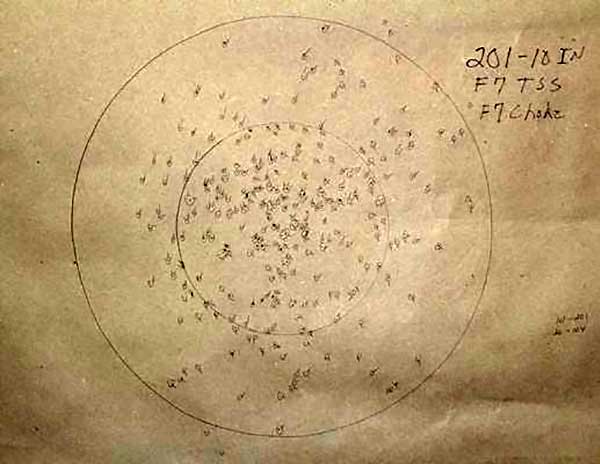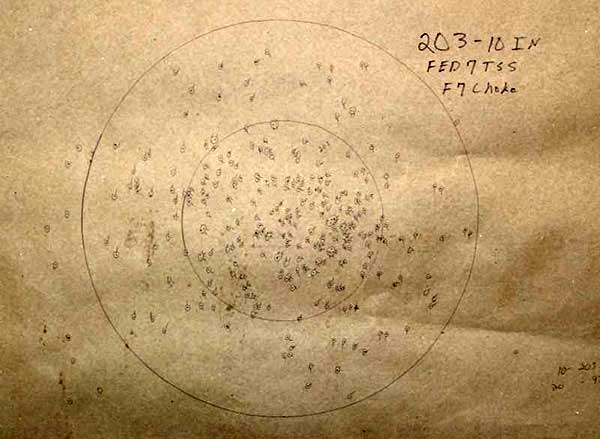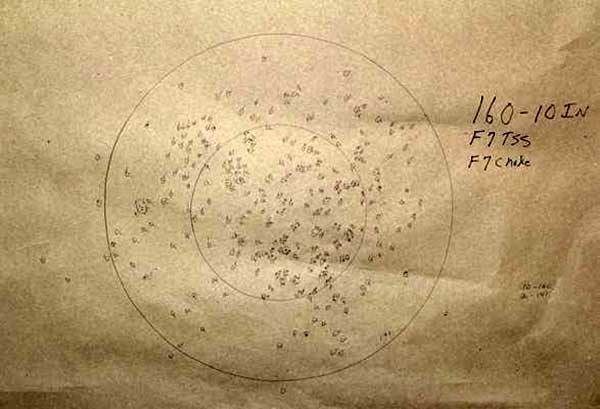The experts at Trulock Chokes give us some inside tip on how to pattern choke tubes in your turkey shotgun.

USA – -(Ammoland.com)- This article will explain how to pattern choke tubes with constrictions suitable for turkey hunting.
Patterning shotguns for turkey hunting is a little different from what you would normally do for upland bird or waterfowl hunting. The primary difference is that you will be using a 10 inch diameter circle instead of a 30 in circle.
* Most turkey hunters want a very dense core with as many pellets as possible in a nominal 10 inch circle. This is much smaller than the typical 30 inch circle used in patterning for other types of hunting.
* The shotgun is aimed instead of pointed for the vast majority of shots taken.
* Most shots are taken from a sitting or kneeling position.
Patterning your shotgun should be done when:
- Using a gun that is new to you.
- Using a different brand of shotshell, even if it duplicates a load you have already patterned.
- Using a different load, different velocity, different throw weight, different size shot, etc.
- Using a different choke tube, even if it has the same exit diameter as a previously patterned choke.
- Anytime you change anything at all, gun, shell or choke tube, you need to pattern the shotgun.
Materials and equipment needed to pattern Choke Tubes for Turkey Hunting:
- A minimum of 5 sheets of poster board, butcher paper, etc., that measures nominally at a minimum 3 feet square. We prefer 4 feet for the simple reason that if your shotgun is not shooting to the point of aim, smaller sized paper may not show the entire pattern. If your gun is shooting to a different spot than the aiming point you may think you are getting a poor pattern when in fact you could have a very good pattern but part of it is off the paper. Smaller sheets can be taped together to obtain larger dimensions.
- Magic marker or something similar to make a distinct aiming point in the center of the target.
- 5 identical shot shells. Never use different brands or different loads during the tests.
- Note that you are shooting each choke/ load combination you test a minimum of 5 times.
- Some sort of padded rest from which to shoot. This is needed to remove gun wobble you would have if you were to shoot offhand. A solid shooting bench would be preferred.
- Tape measure or some device to accurately measure the distance from the shotgun muzzle to the target.
- Target stand, actually anything at all to which you can attach your target paper.
- Some device, such as a protractor to draw a 10 inch diameter circle on the target, (we use a 10 inch diameter piece of Lexan. This allows us to see the pattern as we move it on the target.) It can be as simple as a nail tied to a pencil with a piece of string to position them 5 inches apart.
I believe that many turkey hunters are now using replica turkey silhouette targets to pattern their guns instead of the larger target as described above.
This is fine IF you know the point of impact versus the point of aim and you can compensate for the difference. However, if you have changed anything on your gun as mentioned above you don’t know if this crucial detail has been affected. Changing choke tubes or using similar shells should not alter the point of impact by any “significant” degree but it can happen! Do you really want to miss or even worse, wound a turkey because you did not take the time to make sure?
- Measure the distance at which you want to pattern from your shooting position and set up your target. The most common distance at which patterns are done for turkey hunting is 40 yards. Some turkey shells and choke combinations will enable you to get patterns that are dense enough to reliably kill a turkey at 50 and even 60 yards but I strongly suggest you start at the 40 yard range.
- Carefully aim your shotgun at the center of the target, make sure you have the rib in perfect alignment. You should see a flat plane?????? basically showing just the bead. Keep the bead on the aiming point and squeeze the trigger just like you would when firing a rifle.
- Repeat this 5 times using a different target for each shot.
- Carefully examine each target to visually locate the center point of the most dense portion of pellet strikes and mark that spot. Draw a 10 inch diameter circle centered on your previously made location mark.
- Count the number of hits inside of the 10 inch circle on each target.
- Add the numbers from each target and divide by 5.
- This number will be your average pellet count in the 10 in circle for each of the 5 shots
Just a few short years ago the absolute gold standard everyone strives for was to be able to get 100 pellets in the circle. With the Federal # 7 tungsten loads and the Winchester Long Beard XR loads this should be readily surpassed. While most turkey hunters will never be truly satisfied and will always be searching for the choke or shell that will give them a few more pellets the truth is that the shells for turkey hunting have seen big improvements in the last few years thus making it easier to get clean kills at longer distances.
In addition to seeing the pellet count in the target you will also learn if your point of impact (the center of the 10 inch circle) and your point of aim are the same.
If you want to know the percentage of the pellets in the 10 inch circle you have a little more work to do.
Take 5 additional shells that are the same as the ones you used for patterning.
- Cut the ends, remove all of the shot and put them all into some kind of container.
- Count all of the shot and divide by 5
- This gives you the average number of pellets in each shell.
- Divide the average number of hits in the 10 inch circle that you obtained in step 7 above by the average number of shot in each shell.
- The number you obtain will be the percentage of shot in the 10 inch circle.
In closing let me state that shooting one or two patterns is better than not patterning at all but you will get shot counts that are much closer to a true average by shooting a minimum of 5 times as outlined above. More is always better.
Below you will see an example on a new choke and turkey load we were testing:






About Trulock Chokes:
The staff at Trulock Chokes prides itself on providing excellent service and an excellent line of products. In the event you are not completely satisfied with your purchase you can return it for a refund or exchange within 60 days from the date of purchase – with other firms, the moment you open it, you own it.
For more information, please visit www.TrulockChokes.com.
